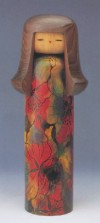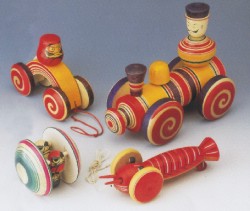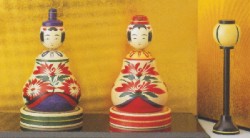| |
Attack
of the
Kokeshi Dolls
Imran H. Khan
 In
today's realm, Barbie seems to be the Queen of dolls who
has conquered the hearts of all young girls (and some boys
too). From a more traditional point of view, we know that
there are various types of folk toys from different parts
of the world that are quite distinctive to the region of
its origin. "All are peculiar to the places where they
emerged as well as to the people living there”, says Shibata
Chokichiro, Director for Japan Traditional Kokeshi Association.
Out of numerous unique folk toys found in Japan, the most
common are the Kokeshi, or wooden dolls. These
dolls are traditionally simple in construction, made of
wood, and shaped with a cylindrical body and round head.
They originated as a child's toy in the Tohoku region of
northern Japan and the tradition has since been passed on
through the generations. In
today's realm, Barbie seems to be the Queen of dolls who
has conquered the hearts of all young girls (and some boys
too). From a more traditional point of view, we know that
there are various types of folk toys from different parts
of the world that are quite distinctive to the region of
its origin. "All are peculiar to the places where they
emerged as well as to the people living there”, says Shibata
Chokichiro, Director for Japan Traditional Kokeshi Association.
Out of numerous unique folk toys found in Japan, the most
common are the Kokeshi, or wooden dolls. These
dolls are traditionally simple in construction, made of
wood, and shaped with a cylindrical body and round head.
They originated as a child's toy in the Tohoku region of
northern Japan and the tradition has since been passed on
through the generations.
 Kokeshi
are usually limbless and painted in bright floral designs,
kimono or in other traditional patters. Traditional kokeshi
can be classified into probably 10 categories based on manufacturing
technique, shape, and decoration. In addition, "contemporary"
kokeshi are now making the scene, incorporating
elements of modern art and sculpture. Kokeshi is
now recognised as one of the traditional folk arts in Japan.
Kokeshi dolls would probably be Barbie's Great
great grand mother as they go back about two hundred years. Kokeshi
are usually limbless and painted in bright floral designs,
kimono or in other traditional patters. Traditional kokeshi
can be classified into probably 10 categories based on manufacturing
technique, shape, and decoration. In addition, "contemporary"
kokeshi are now making the scene, incorporating
elements of modern art and sculpture. Kokeshi is
now recognised as one of the traditional folk arts in Japan.
Kokeshi dolls would probably be Barbie's Great
great grand mother as they go back about two hundred years.
The
Embassy of Japan in collaboration with Bangladesh Shishu
Academy and Bangladesh-Japan Youth Friendship Association
has organised an exhibition titled “The World of Kokeshi
Dolls”, featuring, probably the most enduring of all dolls,
the Japanese Kokeshi Dolls. In this event a great variety
of Kokeshi, creative Kokeshi and any other
handcrafted wooden toys have been brought from Japan. Among
them, some popular faces are the Tsuchiyu, dolls which have
a gooseneck-joint with the body tenon inserted into the
head and the cylindrical body bulge slightly in the middle.
Yajiro was first developed in the village of Yajiro in the
city of Shiroshi. The top of the head is painted with multicolored
lines drawn in a beret cap pattern. Flowers or leaf patterns
may sometimes be added. The Naruko kokeshi had
its head joined to its body with a close fitting gooseneck
that emits a “cry” (hence called the crying doll) when the
head is turned. A special painting technique called uterakashi
is sometimes used in the body. The Nanbu was developed from
an unpainted, pacifier-shaped toy with a movable head. These
dolls are characterised by their simple painting and their
movable head. The Tsugaru's head and body are of one piece.
Some have a wasp waist while others have heavyset shoulders,
reflecting the influence of the Naruko kokeshi.
 This
event, which will remain open till the 3rd of November,
can serve as a tool to showcase the amount of respect and
admiration that the Japanese have for their cultural heritage. This
event, which will remain open till the 3rd of November,
can serve as a tool to showcase the amount of respect and
admiration that the Japanese have for their cultural heritage.
Traditional
Kokeshi
This began when Tohoku's kijiya, woodworkers making
bowls and other household items, turned their craftsmanship
to creating wooden dolls that visitors could buy for their
children. As the typical features were being transmitted
from master to apprentice, father to son, some of them got
distinctive to certain localities. The fact that traditional
kokeshi, with their simple limbless structure,
have so long been treasured as dolls in Japan can be appreciated
in the context of an affinity for siplicity and omission
often seen in Japanese culture.
 Wooden
Toys Wooden
Toys
Traditional Tohoku kokeshi artisans also made other
kinds of wooden toys using the same style and techniques.
They are usually classified into: Tops--consisting
of numerous varieties of tops (koma). Some of their
tops not only spin but also mover in different directions.
Among them are hitting-koma, wrestling-koma, singing-koma,
and much more. There are also vegetable basket koma,
a wooden basket filled with many tops in the shape of vegetables;
Kitchen and Household Items --consisting
of toy teas sets, charcoal cooking braziers and kettles,
mortars and pestles, pots and water jars; Moving Toys which
include toy ducks, demons, tigers, horses, as well as four-wheeled
wagons, trains and automobiles; Dolls for the Girl's
Festival --where the dolls vary from those dolls
that are patterned after the traditional dolls. They also
have accessory items made of wood, including lanterns, votive
offerings and various other implements; Other Toys
have an assortment of toys such as the self-righting tumbler
doll, a small drum with string-attached balls that strike
the heads when the handle is rotated and other such items.
 Creative
Kokeshi Creative
Kokeshi
Whereas traditional kokeshi exhibit a recognisable
local character, creative kokeshi are completely
free in terms of inspiration, shape and painting, the only
traditional constraint being their manufacture by means
of the lathe. Unlike traditional kokeshi, they
do not display any of their distinctive local colour nor
the techniques that had been passed down through the generations.
They simply represent one-generation-only, original piece
of art by individual craftsman. This is relatively a new
concept where most of the artists try to express certain
themes through their work.
|

 In
today's realm, Barbie seems to be the Queen of dolls who
has conquered the hearts of all young girls (and some boys
too). From a more traditional point of view, we know that
there are various types of folk toys from different parts
of the world that are quite distinctive to the region of
its origin. "All are peculiar to the places where they
emerged as well as to the people living there”, says Shibata
Chokichiro, Director for Japan Traditional Kokeshi Association.
Out of numerous unique folk toys found in Japan, the most
common are the Kokeshi, or wooden dolls. These
dolls are traditionally simple in construction, made of
wood, and shaped with a cylindrical body and round head.
They originated as a child's toy in the Tohoku region of
northern Japan and the tradition has since been passed on
through the generations.
In
today's realm, Barbie seems to be the Queen of dolls who
has conquered the hearts of all young girls (and some boys
too). From a more traditional point of view, we know that
there are various types of folk toys from different parts
of the world that are quite distinctive to the region of
its origin. "All are peculiar to the places where they
emerged as well as to the people living there”, says Shibata
Chokichiro, Director for Japan Traditional Kokeshi Association.
Out of numerous unique folk toys found in Japan, the most
common are the Kokeshi, or wooden dolls. These
dolls are traditionally simple in construction, made of
wood, and shaped with a cylindrical body and round head.
They originated as a child's toy in the Tohoku region of
northern Japan and the tradition has since been passed on
through the generations.  Kokeshi
are usually limbless and painted in bright floral designs,
kimono or in other traditional patters. Traditional kokeshi
can be classified into probably 10 categories based on manufacturing
technique, shape, and decoration. In addition, "contemporary"
kokeshi are now making the scene, incorporating
elements of modern art and sculpture. Kokeshi is
now recognised as one of the traditional folk arts in Japan.
Kokeshi dolls would probably be Barbie's Great
great grand mother as they go back about two hundred years.
Kokeshi
are usually limbless and painted in bright floral designs,
kimono or in other traditional patters. Traditional kokeshi
can be classified into probably 10 categories based on manufacturing
technique, shape, and decoration. In addition, "contemporary"
kokeshi are now making the scene, incorporating
elements of modern art and sculpture. Kokeshi is
now recognised as one of the traditional folk arts in Japan.
Kokeshi dolls would probably be Barbie's Great
great grand mother as they go back about two hundred years.
 This
event, which will remain open till the 3rd of November,
can serve as a tool to showcase the amount of respect and
admiration that the Japanese have for their cultural heritage.
This
event, which will remain open till the 3rd of November,
can serve as a tool to showcase the amount of respect and
admiration that the Japanese have for their cultural heritage. Wooden
Toys
Wooden
Toys  Creative
Kokeshi
Creative
Kokeshi